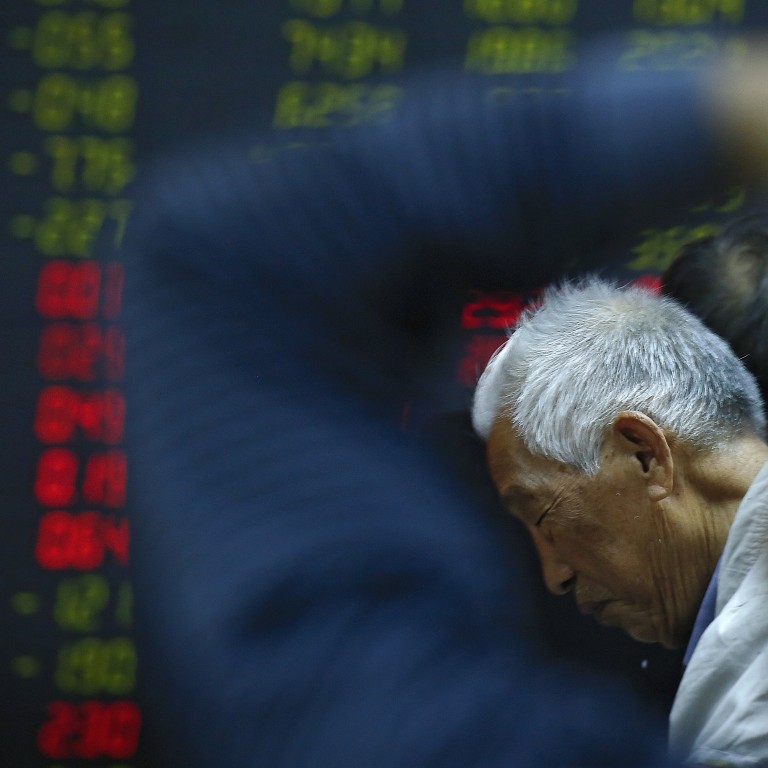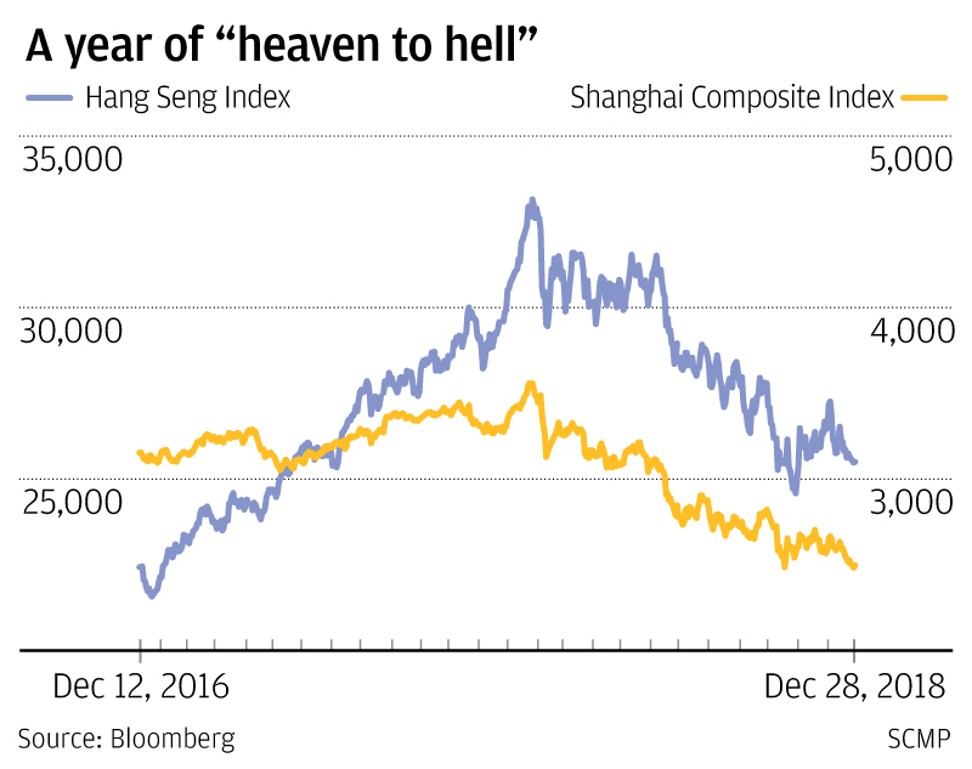
What should traders of Hong Kong, China stocks expect after a year of ‘heaven to hell’?
- Fears about trade war, China’s slowing economy and US interest rate hikes pushed the Hong Kong and China markets off the cliff
- But opportunities may be ahead in cheap valuations and China’s stimulus policy, analysts say
Stock traders, get ready for a better year.
2018 was downright grisly for Hong Kong and mainland China markets.
But market watchers expect things will pick up.
Deutsche Bank, for example, predicts a 10 per cent rise in the Hong Kong market, while Morgan Stanley and Goldman Sachs forecast single-digit returns in the city. UBS says China will deliver a high single-digit rate of growth.
The big elephant in the room is the US-China trade war. A positive resolution could spark a rally in both Hong Kong and mainland markets, as beaten-down stocks look cheap and very eager to get up off the floor.
Any gain would be a far cry from this year, when the Hang Seng Index as of the close of Friday was down 15 per cent while the Shanghai Composite Index closed down 25 per cent, making it the worst performing major market in the world.
Combined, they suffered a market capitalisation loss of US$2.5 trillion, or roughly the gross domestic product of the UK in 2017.
Those losses stung, especially coming off of 2017 – a terrific year for Hong Kong traders. The Hang Seng was the best performing major market in the world, with a run-up of 36 per cent. The Shanghai Composite gained 6.6 per cent.
“We went from heaven to hell in the space of one year,” said Francis Lun, chief executive of Geo Securities.
Some traders trusted their gut and got out of the carnage early. Lu Shunxi, a Shanghai-based investment director at an asset management company, decided in June to take everything out of the market and pocket his 30 per cent gain.
“It felt awesome when the market plunged when it opened on the next trading day,” Lu recalls with a mix of pride and relief.
But others weren’t so lucky.
Anyone who held onto Chinese internet giant Tencent – the heavyweight on the Hang Seng – saw jaw-dropping losses. It had fallen 24 per cent this year as of Friday. That was after it soared to an all-time high of HK$475 in January, more than double from a year earlier. A Chinese government clampdown on gaming was partly to blame.
Meanwhile, Hong Kong’s more than 400 pension funds lost 5.9 per cent on average from January to the end of November, latest data by Refinitiv Lipper shows. Each contributing employee lost on average HK$14,139 (US$1,805) during the period, according to Convoy.
“The madness and fears in the market far exceeded my expectations,” said Nick Liang, chief executive of iMeigu Capital Management, which focuses on China’s internet companies listed in Hong Kong and the US.
‘All parties must end’
Things were looking perky at the kick-off to 2018.
In January, the Hang Sang Index soared to an all-time high while Chinese stocks climbed to the highest level since the 2015 market crash, in line with US markets that charged ahead amid confidence in economic growth and tech stocks.
But the bull run came to an abrupt halt in February when fears about sharper interest rate hikes toppled the US markets, prompting a 10 per cent plunge of the Hang Sang Index in a short 12 days.
Tariff threats made by US President Donald Trump between February and March further weighed on market sentiment.
The next hammering came in June, when Trump declared the US would impose a 25 per cent tariffs on US$50 billion of Chinese goods, prompting China to match with similar tariffs.
The Hang Seng Index slumped by more than 10 per cent within one month from a June high, while the Shanghai Composite Index tumbled 12 per cent.
At the same time, China’s economic indicators pointed to a slowdown. Growth of industrial output slowed and manufacturing activities stalled.
More tariff proposals and trade talks that fell through in August and September accelerated the markets’ declines.
Tech and other new economy stocks were among the year’s biggest disappointments. Before its fall, Tencent moved from HK$200 at the beginning of 2017 to HK$475 in January of this year, in what Geo Securities’ Lun calls the “biggest percentage gain in any blue chip in memory.”
“Many people became millionaires because of Tencent, and fortunes rose and fell with Tencent,” he said.
“I saw that all parties must end one day, so I sold all Tencent I had in March at about HK$430,” said Lun, who considered it his best trade of the year.
Enthusiasm about such stocks was pushed to a climax when Hong Kong introduced historic listing rules reform in April, allowing companies with dual-class shares and pre-revenue biotech firms to list.
That gave rise to a surge in initial public offerings of new economy stocks such as smartphone maker Xiaomi and on-demand service giant Meituan Dianping.
Hong Kong reclaimed its crown as the world’s top IPO market in 2018, with a total of HK$278 billion raised, the most since 2010.
But the love affair with new economy stocks was short lived, as the slumping market made investors question their valuation. The Chinese government’s unexpected policy to suspend new game approvals added to the pressure, pounding gaming companies like Tencent.
By the end of the third quarter, Xiaomi traded a third lower than its offering price and Tencent also slumped by one-third from its record high in January.
‘Worst times represent the best opportunities’
Many investors will be happy to sing Auld Lang Syne to say goodbye to 2018 and welcome in the new year. But why should 2019 be any better?
Analysts point to attractive valuations, China’s coming economic stimulus, and a possible end to the US-China trade war.
“Even though volatility is here to stay, our advice is still to stay invested,” said Dennis Lam, an analyst at UBS Global Wealth Management.
Other are more cautious, suggesting investors wait on the sidelines for resolution of such things as the trade war.
Han Chao, chairman of Shenzhen Basaltic Capital Management, describes his strategy for 2019 as “watch and wait until the end of next year”.
“The market will have a better direction after a year of policy changes and political shifts,” he explained.
Kenny Tang Sing-hing of China Hong Kong Capital Asset Management expects things will improve in the second half of the year, while Geo Securities’ Lun says stay on the sidelines until March when he expects the Hong Kong and mainland markets to hit bottom.
Most experts say investors should stay glued to the US-China trade war, which will be one of the top defining drivers of markets.
A final ceasefire in early 2019 could drive “a multi-month rally in Asia ex-Japan equities led by those markets affected, namely Hong Kong, China and Korea,” according to Patrick Pan, an equity strategist at Daiwa Capital Markets.
Daiwa predicts the most likely form of a ceasefire will be something akin to a memo of understanding between the world’s two largest economies. Without some sort of deal, Daiwa expects the market to be weighed down by a possible slowdown in the global economy.
Beyond the trade war, investors may be able to find plenty of attractive opportunities because of cheap valuations and the top leadership’s recent promise to provide policy stimulus for China’s economy at the annual Central Economic Work Conference, analysts say.
Valuations on the Hong Kong and China markets were at the lowest levels since early 2016 and 2015 respectively, measured by price-earnings ratio of the Hang Seng and Shanghai Composite indices.
Significant tax cuts in China through a new personal income tax law taking effect on January 1 will support consumer sentiment, thus benefiting consumer staples in Hong Kong and China, according to Pan.
Higher government spending outlined in the policy meeting also “offered clear benefits” to the infrastructure sector as well as banks, which “already look inexpensive and offer attractive dividend yields”, according to Kelvin Tay, regional chief investment officer at UBS.
Defensive tactics are likely to push up utilities and telecoms, according to Pan.
Even the slammed tech stocks could find a way to crawl back from this year’s losses.
Valuations for the likes of Tencent have dropped to a trough, while long-term growth factors such as rising income and online penetration remained solid, according to Tay.
“If the [trade war] situation turns around … a lot of growth stocks still have very much potential and this may even come back to our tech stocks,” said Jingyi Pan, a Singapore-based market strategist at IG.
“At this point of time, it’s definitely time to look into equities,” she said.
Tay of UBS advises investors to stay away from Hong Kong-listed property developers as transactions slow amid an ongoing home-price decline, as well as retailers over the weakening yuan.
Policy risks continue to cloud the outlook of drug makers and Chinese property developers, while falling oil prices will pressure energy stocks, according to Daiwa.
Further inclusion of Chinese stocks into global equity indices will “provide material support” for the market, said Jim McCafferty, head of equity research for Asia ex-Japan at Nomura.
Index provider MSCI is considering expanding the weighting of Chinese shares to 20 per cent from the current 5 per cent, after adding 230 A-shares to its emerging market benchmark in June for the first time.
Other global equity index providers including S&P Dow Jones Indices and FTSE Russell have also announced similar inclusion plans in the next year.
Foreign capital accounted for a mere 6 per cent of the A-share market value in September, according to Haitong Securities.
Lu, the trader who pocketed his eye-watering gains and got out in June, is back testing the mainland Chinese markets.
“I’m bullish on 2019 no matter based on business cycles or valuation levels,” Lu said. “The worst times represent the best opportunities.”



